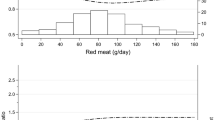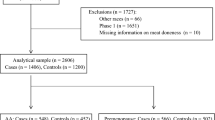Abstract
The relation between the intake of certain food items thought to be precursors or inhibitors of N-nitroso compounds (NOC) and risk of leukemia was investigated in a case-control study among children from birth to age 10 years in Los Angeles County, California (United States). Cases were ascertained through a population-based tumor registry from 1980 to 1987. Controls were drawn from friends and by random-digit dialing. Interviews were obtained from 232 cases and 232 controls. Food items of principal interest were: breakfast meats (bacon, sausage, ham); luncheon meats (salami, pastrami, lunch meat, corned beef, bologna); hot dogs; oranges and organge juice; and grapefruit and grapefruit juice. We also asked about intake of apples and apple juice, regular and charcoal broiled meats, milk, coffee, and coke or cola drinks. Usual consumption frequencies were determined for both parents and the child. When the risks were adjusted for each other and other risk factors, the only persistent significant associations were for children's intake of hot dogs (odds ratio [OR]=9.5, 95 percent confidence interval [CI]=1.6–57.6 for 12 or more hot dogs per month, trendP=0.01), and fathers' intake of hot dogs (OR=11.0, CI=1.2–98.7 for highest intake category, trendP=0.01). There was no evidence that fruit intake provided protection. While these results are compatible with the experimental animal literature and the hypothesis that human NOC intake is associated with leukemia risk, given potential biases in the data, further study of this hypothesis with more focused and comprehensive epidemiologic studies is warranted.
Similar content being viewed by others
References
Lowengart RA, Peters JM, Cicioni C, et al. Childhood leukemia and parents' occupational and home exposures.JNCI 1987;1: 39–46.
London SJ, Thomas DC, Bowman JD, Sobel E, Cheng TC, Peters JM. Exposure to residential electric and magnetic fields and risk of childhood leukemia.Am J Epidemiol 1991;134: 923–37.
Bunin GR, Kuijten RR, Boesel CP, Buckley JD, Meadows AT. Maternal diet and risk of astrocytic glioma in children.Cancer Causes Control 1994;5: 177–87.
Sarasua S, Savitz DA: Cured and broiled meat consumption in relation to childhood cancer.Cancer Causes Control 1994;5: 141–8.
Hisserich J, Martin SP, Henderson BE. An areawide cancer reporting network.Public Health Rep 1975;90: 15–7.
Mack TM. Cancer surveillance program in Los Angeles county.NCI Monogr 1977;47: 99–101.
Lijinsky W.Chemistry and Biology of N-nitroso Compounds. Cambridge, UK. Cambridge University Press, 1992.
Moser AP, Pitot HC, Dove WF. A dominant mutation that predisposes to multiple intestinal neoplasia in the mouse.Science 1990;247: 322–4.
Preston-Martin S, Yu MC, Henderson BE, Benton B. N-nitroso compounds and childhood brain tumors.Cancer Res 1982;42: 5240–5.
Preston-Martin S, Henderson BE. N-nitroso compounds and human intracranial tumors. In: O'Neill IK, Von Borstel RC, Miller CT, Long J, Bartsch H, eds.N-nitroso Compounds: Occurrence, Biological Effects and Relevance to Human Cancer. Lyon, France: International Agency for Research on Cancer, 1984; IARC Sci. Pub. No. 57.
Preston-Martin S, Correa P. Epidemiologic evidence for the role of N-nitroso compounds in human cancer.Cancer Surv 1989;8: 459–73.
Frei JV. Toxicity, tissue changes, and tumor induction in inbred Swiss mice by methylnitrosamine and-amide compounds.Cancer Res 1970;30: 11–7.
Vesselinovitch SD, Rao KVN, Mihailovich N. Neoplastic response of mouse tissues during perinatal age periods and its significance in chemical carcinogenesis.NCI Monogr 1979;51: 239–50.
Mende P, Spiegelhalder B, Preussmann R. Trace analysis of nitrosated foodstuffs for nitrosamides.Food Chem Toxicol 1991;29: 167–72.
Giner-Sorolla A, Greenbaum JH, Last-Barney K, Anderson LM. N6(methylnitroso) adenosine: a carcinogenic nitrosamine derived from a naturally-occurring nucleoside.Cancer Lett 1979;6: 79–82.
Borzsonvi M, Torok G, Pinter A, Surjan A, Nadasdi L, Roller P. Carcinogenic effect of dinitrosopiperazine in adult Swiss mice and after transplacental or translactational exposure.Cancer Res 1980;40: 2925–7.
Toth B. A critical review of experiments in chemical carcinogenesis using newborn animals.Cancer Res 1968;28: 727–38.
Zimmerli B, Schlatter J. Ethyl carbamate: analytical methodology, occurrence, formation, biological activity and risk assessment.Mutation Res 1991;259: 325–50.
Lijinsky W. The formation and occurrence of polynuclear aromatic hydrocarbons associated with food.Mutation Res 1991;259: 251–61.
Author information
Authors and Affiliations
Additional information
This work was supported by contract No. 799-24 from the Electric Power Research Institute and NIOSH Grant No. R010H01413. Cancer incidence data have been collected under Subcontract 050C-8709 with the California Public Health Foundation. The subcontract is supported by the California Department of Health Services as part of its statewide cancer reporting program, mandated by Heatth and Safety Code section 210 and 211.3. The ideas and opinions expressed herein are those of the authors, and no endorsement of the State of California, Department of Health Services or the California Public Health Foundation is intended or should be inferred.
Rights and permissions
About this article
Cite this article
Peters, J.M., Preston-Martin, S., London, S.J. et al. Processed meats and risk of childhood leukemia (California, USA). Cancer Causes Control 5, 195–202 (1994). https://doi.org/10.1007/BF01830266
Received:
Accepted:
Issue Date:
DOI: https://doi.org/10.1007/BF01830266




